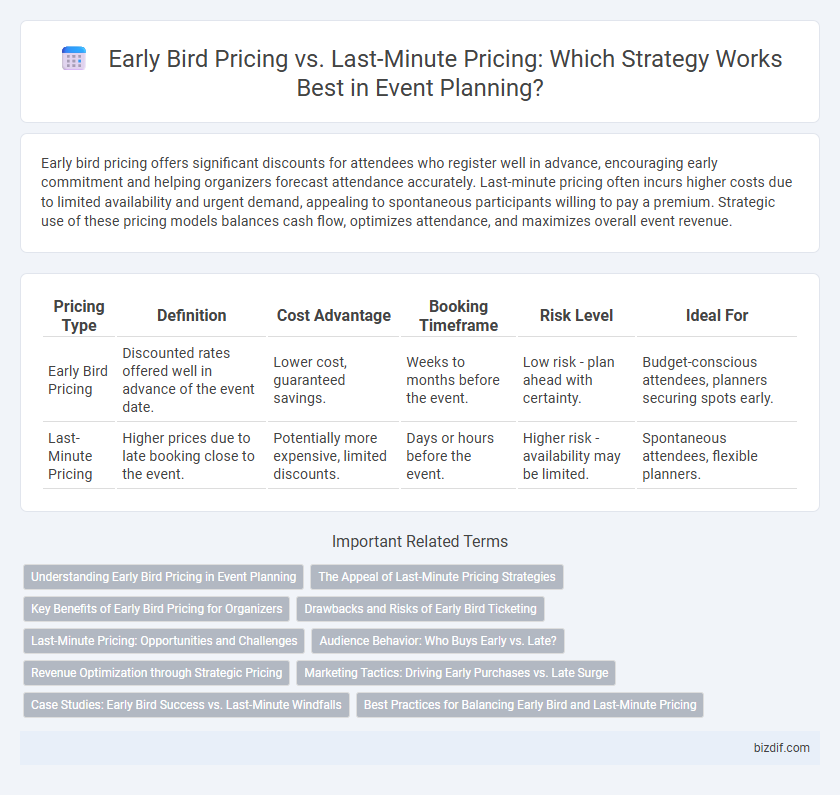Early bird pricing offers significant discounts for attendees who register well in advance, encouraging early commitment and helping organizers forecast attendance accurately. Last-minute pricing often incurs higher costs due to limited availability and urgent demand, appealing to spontaneous participants willing to pay a premium. Strategic use of these pricing models balances cash flow, optimizes attendance, and maximizes overall event revenue.
Table of Comparison
| Pricing Type | Definition | Cost Advantage | Booking Timeframe | Risk Level | Ideal For |
|---|---|---|---|---|---|
| Early Bird Pricing | Discounted rates offered well in advance of the event date. | Lower cost, guaranteed savings. | Weeks to months before the event. | Low risk - plan ahead with certainty. | Budget-conscious attendees, planners securing spots early. |
| Last-Minute Pricing | Higher prices due to late booking close to the event. | Potentially more expensive, limited discounts. | Days or hours before the event. | Higher risk - availability may be limited. | Spontaneous attendees, flexible planners. |
Understanding Early Bird Pricing in Event Planning
Early bird pricing in event planning incentivizes early registration by offering discounted rates well before the event date, allowing organizers to secure initial cash flow and gauge attendance levels. This pricing strategy enhances budget forecasting and resource allocation, enabling a smoother logistical setup. Understanding early bird pricing mechanisms helps event planners balance demand, optimize ticket sales, and maximize overall revenue.
The Appeal of Last-Minute Pricing Strategies
Last-minute pricing strategies appeal to spontaneous attendees by offering discounted rates close to the event date, often boosting overall ticket sales. This approach leverages urgency and scarcity, motivating potential participants who delay decisions to commit quickly. Event planners benefit from increased cash flow and reduced unsold inventory by tapping into this market segment.
Key Benefits of Early Bird Pricing for Organizers
Early bird pricing boosts early cash flow and enhances financial stability for event organizers by securing funds well before the event date. It enables accurate attendee forecasting and resource allocation, reducing the risks of overbooking or underspending on logistics. Offering discounted early rates also maximizes marketing momentum and increases attendee commitment, improving overall event planning efficiency.
Drawbacks and Risks of Early Bird Ticketing
Early bird ticketing can create financial risks due to underestimated initial demand, potentially leading to revenue gaps if later sales decline sharply. Offering steep early discounts may devalue the event's perceived worth and discourage full-price purchases closer to the date. Early commitments also limit flexibility in adjusting event details or pricing based on market feedback and demand fluctuations.
Last-Minute Pricing: Opportunities and Challenges
Last-minute pricing in event planning offers opportunities to fill remaining seats and boost revenue by attracting spontaneous attendees willing to pay premium prices. However, it poses challenges such as unpredictable demand, potential revenue loss from discounted offers, and logistical difficulties in preparing for sudden increases in participants. Strategic use of dynamic pricing tools and real-time data analytics can help optimize last-minute sales while managing operational risks effectively.
Audience Behavior: Who Buys Early vs. Late?
Audience behavior reveals that early bird pricing mainly attracts budget-conscious planners and loyal attendees who prioritize guaranteed spots and savings. Last-minute pricing often appeals to spontaneous buyers and those with uncertain schedules who decide only after assessing other commitments. Understanding these segments helps event organizers tailor marketing strategies to maximize sales and attendance.
Revenue Optimization through Strategic Pricing
Early bird pricing captures early commitments by offering discounted rates, improving cash flow and reducing uncertainty for event planners. Last-minute pricing capitalizes on remaining demand, often at higher rates, maximizing revenue from spontaneous buyers. Strategic pricing balances these approaches, leveraging consumer behavior patterns and demand elasticity to optimize overall event revenue.
Marketing Tactics: Driving Early Purchases vs. Late Surge
Early bird pricing leverages urgency and exclusivity to drive early ticket sales, securing cash flow and enabling better event forecasting. Last-minute pricing capitalizes on scarcity and last-chance appeal, targeting spontaneous buyers and maximizing revenue close to the event date. Combining both strategies optimizes attendance by balancing early commitments with late demand spikes.
Case Studies: Early Bird Success vs. Last-Minute Windfalls
Case studies reveal that early bird pricing strategies increase attendee commitment and improve cash flow months before the event, often resulting in a 20-30% higher overall attendance rate. Conversely, last-minute pricing captures spontaneous registrants, frequently generating a surge of up to 15% additional revenue close to the event date. Balancing early bird discounts with strategic last-minute price adjustments optimizes both attendance and profitability in event planning.
Best Practices for Balancing Early Bird and Last-Minute Pricing
Effective event planning requires a strategic balance between early bird and last-minute pricing to maximize attendance and revenue. Offering attractive early bird discounts incentivizes early registrations and improves cash flow, while limited last-minute deals can capture hesitant attendees without devaluing the event. Employing dynamic pricing models and clear communication ensures both price points complement each other, driving sustained demand and optimizing overall event profitability.
Early bird pricing vs Last-minute pricing Infographic

 bizdif.com
bizdif.com